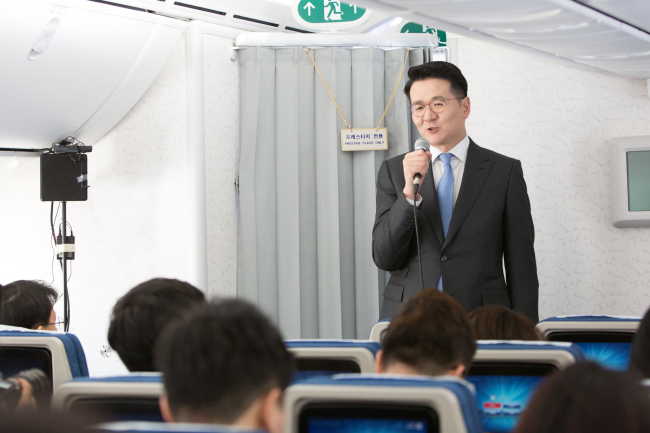Korean Air president pledges to push growth with new B787s
By Won Ho-jungPublished : Feb. 27, 2017 - 16:15
Korean Air’s new President Cho Won-tae on Monday said the airline will aim to boost sales with its cutting-edge aircraft and ensure passenger safety by making changes to the carrier’s safety policies.
At an event at Korean Air’s Incheon Airport hangar to unveil the new Boeing 787-9 Dreamliner that will begin servicing flights in mid-March, Cho spoke to reporters on board the plane in his first public press appearance since being named president.
Cho, who is the son of Korean Air Chief Executive Officer and Hanjin Group Chairman Cho Yang-ho, was named president and chief operating officer of Korean Air last month.
At an event at Korean Air’s Incheon Airport hangar to unveil the new Boeing 787-9 Dreamliner that will begin servicing flights in mid-March, Cho spoke to reporters on board the plane in his first public press appearance since being named president.
Cho, who is the son of Korean Air Chief Executive Officer and Hanjin Group Chairman Cho Yang-ho, was named president and chief operating officer of Korean Air last month.

“We decided that the B787 was the top plane in terms of fuel efficiency or customer convenience, which is why we chose it,” Cho said, when asked about the B787’s competitiveness over the Airbus 350-900, which will be brought in by rival airline Asiana Airlines.
“This is our first mid-sized plane that can service long-haul flights, so we will be supplying the plane according to demand.”
The B787, which seats 269 passengers including six first-class and 18 prestige (business) class seats, will begin flights between Jeju and Gimpo on March 12. The airline plans to bring in 10 B787s -- five of them within the year -- to service long-haul flights such as those to Los Angeles, Madrid and Toronto.
It is a significant model for Korean Air, which partnered with Boeing to manufacture and supply parts of the plane including the wheel-well bulkhead, nose-wheel well, raked wing tips and stringer.
Although these will be the first B787s to be flown by a Korean airline, they are not completely new models. There are 525 B787s already in the skies around the world, according to Darren Hulst, Boeing's Managing Director of marketing for Northeast Asia.
Cho said the airplane’s greatest strengths were in its fuel efficiency, which was increased by 20 percent compared to previous planes, and its relatively small size, which will make it easier to fill flights and raise revenue.
He said the airline’s revenue goal for 2017 was 12 trillion won ($10.6 billion), slightly up from 2016’s 11.7 trillion won. With increased revenue, he said he hoped to start reducing Korean Air’s 1,000 percent debt ratio.
“It may seem difficult to see how we can reduce our debt ratio while paying for new planes,” Cho said. “But as soon as these planes start service, they start creating revenue. By bringing in long-haul planes like (the B787) we can increase the supply of flights and maximize our revenue to pay down debt.”
In addition to the new planes, Cho said that he hoped to increase customer satisfaction by addressing some of the issues over in-flight safety that came up last year after a widely publicized incident of a drunken unruly passenger assaulting flight attendants.
“Until now, Korean Air has been very sensitive only to passengers’ opinions,” he said, referring to criticism that flight attendants were hesitant to restrain unruly passengers due to a fear of punishment. “From now on, we will trust our captains and flight attendants to make decisions about whether someone poses a danger to other passengers or to safe flight operations,” he said.
By Won Ho-jung (hjwon@heraldcorp.com)











![[Hello India] Hyundai Motor vows to boost 'clean mobility' in India](http://res.heraldm.com/phpwas/restmb_idxmake.php?idx=644&simg=/content/image/2024/04/25/20240425050672_0.jpg&u=)







